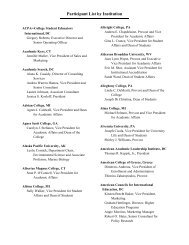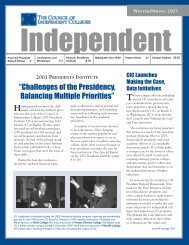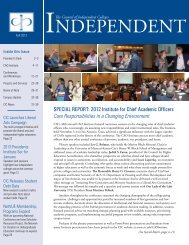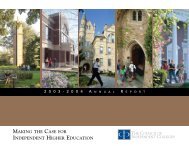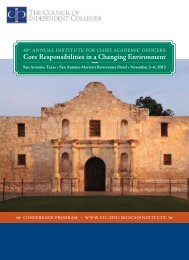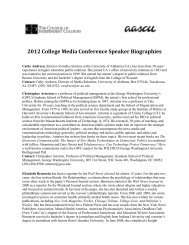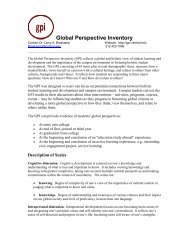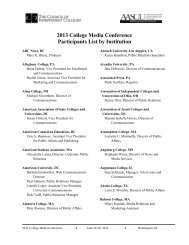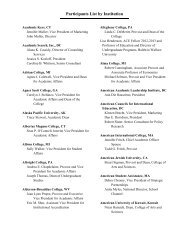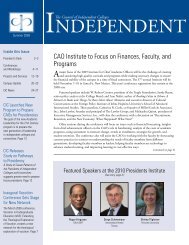Meeting the Challenge: - The Council of Independent Colleges
Meeting the Challenge: - The Council of Independent Colleges
Meeting the Challenge: - The Council of Independent Colleges
Create successful ePaper yourself
Turn your PDF publications into a flip-book with our unique Google optimized e-Paper software.
John R. <strong>The</strong>lin<br />
records in science and ma<strong>the</strong>matics initiatives—such as<br />
Allegheny and Juniata <strong>Colleges</strong> and Susquehanna University<br />
in Pennsylvania, Knox College in Illinois, Hope and<br />
Calvin <strong>Colleges</strong> in Michigan, Xavier University in Ohio,<br />
and Drury University in Missouri. Drury, for example,<br />
has gained stature for its leadership role in <strong>the</strong> National<br />
Science Foundation’s “Course and Curriculum Development<br />
Program.” And Dickinson College in Pennsylvania was <strong>the</strong><br />
host campus for three model national programs: Workshop<br />
Physics, Workshop Ma<strong>the</strong>matics, and Workshop Calculus.<br />
One <strong>of</strong> <strong>the</strong> best indicators <strong>of</strong> continuing excellence in<br />
undergraduate science has been CIC’s annual Heuer Awards<br />
for Outstanding Achievement in Undergraduate Science<br />
Education, which between 2001 and 2005 honored a range<br />
<strong>of</strong> CIC member institutions, including Juniata, Oberlin,<br />
Whitworth, Benedictine, and Allegheny <strong>Colleges</strong>, and<br />
Drury and John Carroll Universities. Most <strong>of</strong> <strong>the</strong> awardwinning<br />
projects focus on science majors; but o<strong>the</strong>rs, like<br />
Columbia College Chicago’s “Institute for Science Education<br />
and Science Communication,” are designed to improve <strong>the</strong><br />
science education <strong>of</strong> non-science majors.<br />
Liberal arts colleges have excelled in o<strong>the</strong>r national<br />
initiatives. Mount Holyoke, Cedar Crest, and Spelman<br />
<strong>Colleges</strong> stand out as models for <strong>the</strong> education <strong>of</strong> women<br />
in science and ma<strong>the</strong>matics. Spelman and Morehouse<br />
<strong>Colleges</strong> are innovators in science education at historically<br />
black colleges and universities. Spelman warrants special<br />
recognition. According to an analysis provided by <strong>the</strong> United<br />
Negro College Fund, Spelman ranks first in <strong>the</strong> nation<br />
in graduating African-American students with majors in<br />
ma<strong>the</strong>matics and statistics. According to a U.S. News & World<br />
Report survey, more than a third <strong>of</strong> Spelman students major<br />
in ma<strong>the</strong>matics and science fields at this all-women’s college.<br />
Although <strong>the</strong> small liberal arts colleges by definition<br />
do not <strong>of</strong>fer Ph.D. programs in <strong>the</strong> sciences, <strong>the</strong>y have<br />
well prepared a significant number <strong>of</strong> future scientists.<br />
<strong>The</strong>y have been hailed as a robust pipeline to graduate<br />
Many systematic<br />
studies now<br />
show that small<br />
colleges, such as<br />
Juniata College<br />
in Pennsylvania,<br />
made significant<br />
contributions to<br />
<strong>the</strong> education <strong>of</strong><br />
future scientists<br />
throughout <strong>the</strong><br />
20 th century.<br />
21



